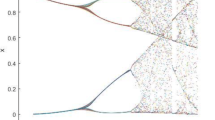Abstract
A large number of digital pictures have many security threats in the transmission on the Internet, and various encryption technologies for images have been proposed. The existing image encryption technology has a simple structure and a small key space, which cannot meet the requirement for image information security at this stage. In order to improve the effectiveness of image encryption and enhance the adaptive ability of image encryption, based on the theory of wavelet transform, chaos theory and adaptive encryption, this paper designs the overall framework of image encryption, and proposes a digital image adaptive encryption method based on lifting wavelet optimization. Firstly, the framework of image frequency domain adaptive encryption algorithm is designed, wavelet transform based on lifting is studied and analyzed, and lifting wavelet optimization method based on improved threshold method and particle swarm algorithm is given to improve the adaptability to image decomposition, so that the frequency domain coefficients obtained after wavelet decomposition can better represent the image content, thus making frequency domain encryption more targeted. Chaos mapping is used to encrypt the pixel gray value and scramble the pixel position of the decomposed low frequency coefficients of the image, thus achieving good image adaptive encryption.






Similar content being viewed by others
References
Antonini M et al (1992) Image coding using wavelet transforms [J]. IEEE Transactions on Image Processing A Publication of the IEEE Signal Processing Society 1(2):205–220
Brodatz image database http://www.humanscan.de/support/downloads/facedb.php
Chai X (2017) An image encryption algorithm based on bit level Brownian motion and new chaotic systems [J]. Multimedia Tools & Applications 76(1):1159–1175
Daubechies I et al (1998) Factoring wavelet transforms into lifting steps [J]. Journal of Fourier Analysis & Applications 4(3):247–269
Hu H, Ye H (2016) Adaptive wavelet bases and image denoising.[J]. Communication on Applied Mathematics & Computation 30(01):156–164
Lewis AS et al (2002) Image compression using the 2-D wavelet transforms [J]. IEEE Trans Image Process 1(2):244–250
Li X et al (2011) Research on power information encryption algorithm based on composite chaotic system in wavelet transform domain [J]. Procedia Engineering 15:2118–2122
Lv X, Liao X, Yang B (2018) A novel scheme for simultaneous image compression and encryption based on wavelet packet transform and multi-chaotic systems [J]. Multimed Tools Appl. https://doi.org/10.1007/s11042-018-6013-6
Ma X, Zhou X, An FP (2018) Fast bi-dimensional empirical mode decomposition (BEMD) based on variable neighborhood window method [J]. Multimed Tools Appl. https://doi.org/10.1007/s11042-018-6629-6
Mallat S (2009) A wavelet tour of signal processing [J] 31(3):83–85
Mallat S (2009) An efficient image representation for multiscale analysis [J]. Biometrics 65(65):143–151
Ren K, Zhang K, Xie B (2012) Adaptive blind video watermarking algorithm based on low frequency coefficients in wavelet domain [J]. Video Engineering 89(62):131–149
Sweldens W (1996) The lifting scheme: a custom-design construction of biorthogonal wavelets [J]. Applied & Computational Harmonic Analysis 3(2):186–200
Tang P, Zhang J, Wang X et al (2017) Learning extremely shared middle-level image representation for scene classification. Knowl Inf Syst 52(2):509–530
Tang L, Qian J, Li L et al (2017) Multimodal medical image fusion based on discrete T chebichef moments and pulse coupled neural network [J]. International Journal of Imaging Systems & Technology 27(1):57–65
Tanmoy R, Tshilidzi M, Snehashish C (2018) Precise detection of speech endpoints dynamically: a wavelet convolution based approach [J]. Commun Nonlinear Sci Numer Simul. https://doi.org/10.1016/j.cnsns.2018.07.008
Technometrics (2000) Logistic regression using the SAS® system [J]. Technometrics (3):323–324
Uehara T, Safavi-Naini R, Ogunbona P (2000) Securing wavelet compression with random permutations[C]. Faculty of Informatics-papers
Wang YM, Li T (2012) Digital watermarking based on chaotic encryption and wavelet transformation [J]. Adv Mater Res 403-408:3054–3058
Wang X, Wang P, Zhang P et al (2013) A norm-space, adaptive, and blind audio watermarking algorithm by discrete wavelet transform [J]. Signal Process 93(4):913–922
Wu Y, Tong Y, Zhu X et al (2018) NOSEP: nonoverlapping sequence pattern mining with gap constraints. IEEE Transactions on Cybernetics 48(10):2809–2822
Xingmin M, Shenggang X, Fengping A, Fuhong L (2018) A novel real-time image restoration algorithm in edge computing [J]. Wirel Commun Mob Comput 9(4):1441–1456
Xue Y, Chen WN, Gu T et al (2017) Set-based discrete particle swarm optimization based on decomposition for permutation-based multiobjective combinatorial optimization problems [J]. IEEE Transactions on Cybernetics 48(7):2139–2153
Yang B, Li S (2010) Multifocus image fusion and restoration with sparse representation [J]. IEEE Transactions on Instrumentation & Measurement 59(4):884–892
Ye L, Wang J, Fan J et al (2016) Image encryption algorithm based on chaotic system and dynamic S-boxes composed of DNA sequences [J]. Multimedia Tools & Applications 75(8):4363–4382
Author information
Authors and Affiliations
Corresponding author
Additional information
Publisher’s note
Springer Nature remains neutral with regard to jurisdictional claims in published maps and institutional affiliations.
Rights and permissions
About this article
Cite this article
Wang, J., Liu, W. & Zhang, S. Adaptive encryption of digital images based on lifting wavelet optimization. Multimed Tools Appl 79, 9363–9386 (2020). https://doi.org/10.1007/s11042-019-7704-3
Received:
Revised:
Accepted:
Published:
Issue Date:
DOI: https://doi.org/10.1007/s11042-019-7704-3




